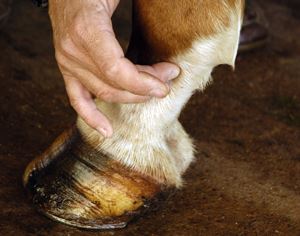While most people see lush, green grasses as a hallmark of spring, many horse owners see bright green warning signs dotting Kentucky fields.
By Sarah E. Coleman
The heavy rains we’ve gotten in Kentucky this spring have led to rich, lush grasses in many pastures and fields. For those who own easy-keeping equine companions, the bright green fields, while lovely to look at, could be a potential disaster.
Horses that “get fat on air” have a higher insulin response, meaning they are at a greater risk of developing laminitis. It has been theorized that this greater insulin reactivity is an evolutionary response from when forage was difficult to come by or of poor quality. When these conditions occurred, it was necessary for a horse to release greater amounts of insulin to support body condition.
When food was plentiful, the increased insulin response allowed horses to lay down more fat, which in turn helped them survive harsh winters. While helpful years ago when herds were wild, this insulin response can be frustrating for modern-day horse owners.
The intake of high-quality pasture (sometimes constant if your horse is out 24/7) that is high in non-structural carbohydrates (NSC) can create sustained levels of high insulin, which can contribute to pasture-associated laminitis. Studies have shown that maintaining very high levels of insulin for 48 to 72 hours in otherwise “normal” horses will reliably cause laminitis. (Asplin et al., 2007, de Laat et al 2012).
The Signs of Laminitis
A very painful condition that affects the laminae in a horse’s hooves, the terms “founder” and “laminitis” are typically used interchangeably, but “founder” generally references outwardly visible signs on the hoof, such as founder rings.
While many of us are well versed in what a stereotypical founder case looks like, recent research has indicated that what had once been considered a hallmark of the disease, the “founder stance,” is actually found in less than 50 percent of cases. In this position, a horse stands with his legs stretched far out in front of him, rocking back on his hind legs to alleviate as much weight bearing as possible on his front limbs.

In a British study of 381 laminitic horses, laminitis was found to occur in all four feet, but both front feet were most commonly and most severely affected, followed by the right fore alone, the left fore alone, then the right hind and left hind, then all four feet. http://www.scarsdalevets.com/wp-content/uploads/2016/02/DocsEquineCareAboutLaminitis2016.pdf
Although there were no individual signs present in all577 cases used in a 2013 study, the most common signs included:
- difficulty turning
- increased digital pulse
- short, choppy walk
Because some of these common laminitis signs could easily be confused with other conditions (like arthritis), it’s important to be vigilant in the observation of horses turned out on lush grasses.
 Becoming familiar with your horse or pony’s normal temperament, gait, hoof temperature and digital pulse will help you notice any abnormal changes. Be aware that the above clinical signs, though being common, don't always occur in every case, so it’s important to also keep an eye out for general discomfort and foot lameness.
Becoming familiar with your horse or pony’s normal temperament, gait, hoof temperature and digital pulse will help you notice any abnormal changes. Be aware that the above clinical signs, though being common, don't always occur in every case, so it’s important to also keep an eye out for general discomfort and foot lameness.
Do All Grasses Cause Laminitis?
Not all grasses are harmful to horses. Classified as either cool- or warm-season, depending on how and when they metabolize and photosynthesize sunlight, specific grasses pose health threats at different times of the year. In the spring, cool-season grasses like tall fescue, timothy and orchardgrass are the main concerns for horse owners.
How to Prevent Laminitis
Horses prone to laminitis are those that are overweight or those that have metabolic issues. If your farm has a plethora of these grasses and your horse is prone to laminitis, the following precautions are recommended:
- Adapt him to new spring grasses gradually (start with one hour and increase by 30 minutes each day)
- Place a muzzle on your horse at all times when he’s turned out
- Put him in a drylot
- If you don’t have access to a drylot, only turn your horse out in the very early morning while wearing a muzzle
Take lateral X-rays of your horses feet twice a year to monitor coffin bone position
